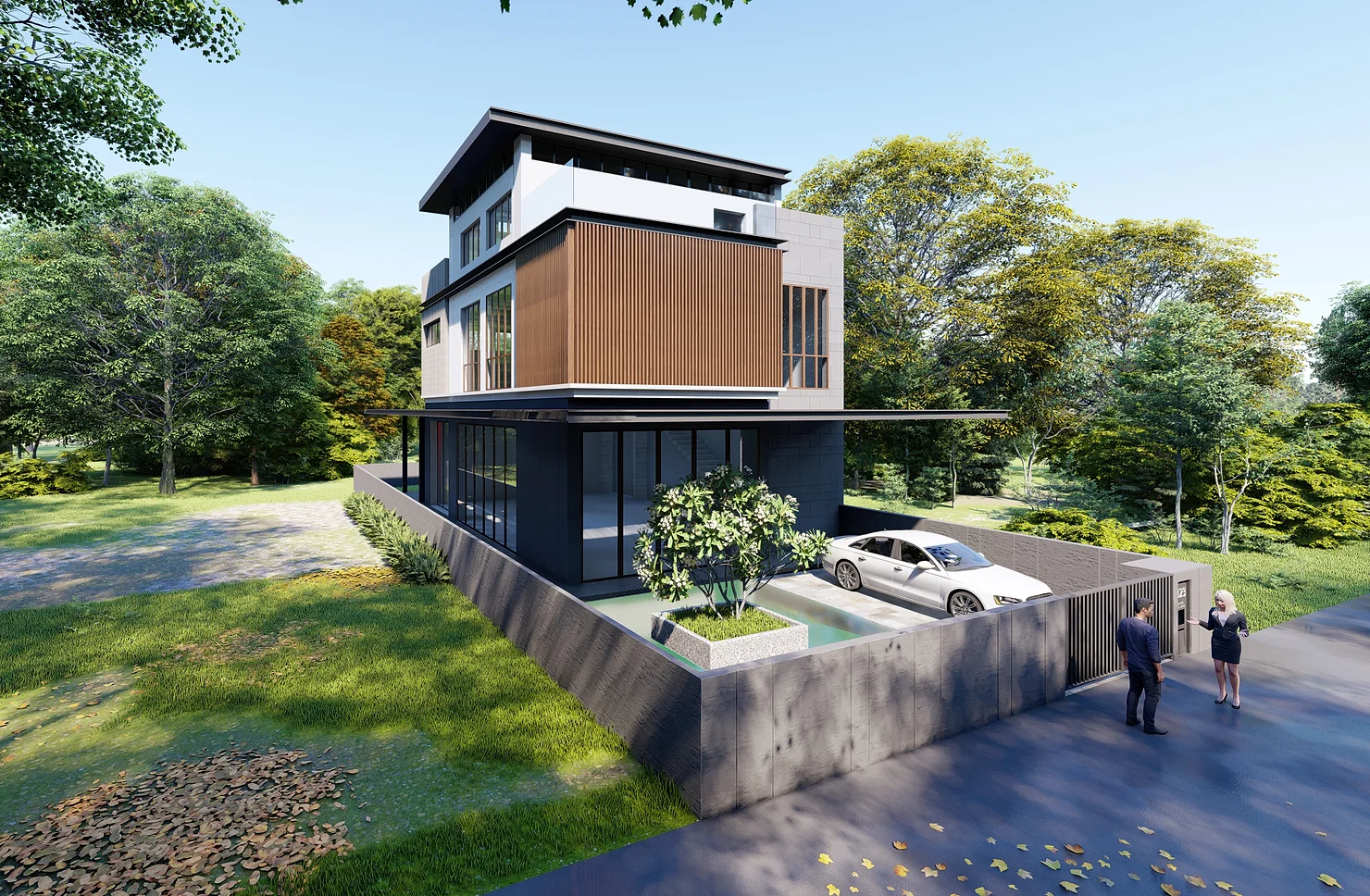The Singapore real estate market is always changing. As homeowners look to upgrade and transform their homes, the demand for house renovations and rebuilds has increased, though many people we speak to aren’t sure where to get started. One of the best way to navigate this process is through a Design & Build contract.
Renovating or rebuilding a house in Singapore involves many considerations, and nothing is more important than the structure of your contract. The Design & Build (D&B) contract is the most streamlined and comprehensive amongst the options available.
As a trusted Design and Build Contractor in Singapore, we’re going to break down what a D&B contract means and why it might be the way to go for your home renovation project. We’ll look into what Design & Build contracts are, their benefits and how this applies to house renovations and rebuilds in Singapore.
First, what is a Design & Build Contract?
A Design & Build contract is a procurement method where a single entity, often a design and construction firm or a contractor with in-house design capabilities, manages both the design and construction phases of a project.
In this arrangement, the responsibility for both design and construction is with one party; it’s a holistic approach. In Singapore, these contracts are commonly used for residential renovations and rebuilds.
This is usually presented as in contrast to tendering, which engages a designer (like an architect) to create the design, and then tenders the construction work out separately to a contractor. This results in two separate contracts, as opposed to the singular contact you get with a Design & Build Contact.
For renovations and rebuilds, a Design and Build contract can often prove to be the more flexible and overall better choice.
What are the benefits of a Design and Build Contract?
With Design & Build Contracts, you’re dealing with a single entity as opposed to several. This alone offers you a variety of benefits that make it the best option for many people looking for renovations and rebuilds. However, there’s more to it than that, and there are more advantages that come from opting for this type of build.
1. A single Point of Contact
As mentioned, the primary advantage of a Design & Build contract is the single point of responsibility it offers (and the benefits that come from that).
Instead of dealing with separate designers, architects, and contractors, homeowners communicate and collaborate with a single entity throughout the project. This streamlines pretty much everything, from decision-making through to taking accountability for the decisions made.
2. Shorter timeline
The greatest benefit of only having a single point of contact is that the process becomes much smoother than having to deal with multiple different contractors and designers.
The process typically starts with the homeowner outlining their requirements and preferences to the Design & Build firm. The firm then takes on the responsibility of conceptualising, designing, obtaining necessary approvals, and then executing the construction, all within the agreed-upon budget and timeline.
This will often lead to quicker project completion. Since design and construction phases can overlap, this usually ends up saving time compared to traditional sequential methods that require approval.
The integration of design and construction under one contract often results in a shorter project timeline. This efficiency is especially important for homeowners who want their renovations or rebuilds completed swiftly.
3. Cost Efficiency
By combining the design and construction phases, potential issues that might arise due to miscommunication or conflicts between designers and builders are minimised. This integration can result in a more efficient and cost-effective project delivery.
With a single entity managing both design and construction, there’s potential for a lot of cost savings as the firm can optimise the design to fit the available budget more effectively. D&B contracts often come with a fixed-price structure too, helping homeowners control their budgets more effectively.
Any potential changes or variations are typically handled through a formal process, providing full transparency and cost predictability.
4. Quality Assurance
Design & Build contractors are motivated to deliver high-quality results, as their reputation is at stake when you place your trust in them for both the design and construction of your project.

Their expertise in both design and construction allows for better control over project quality, and Design & Build contractors have a strong incentive to ensure that the design is sound, as they’re also in charge of construction too.
What’s included in a Design and Build Contract?
Though the contract you end up with may vary, there are some stipulations that are almost always found. The main elements of a design and build contract in Singapore typically include:
- Scope of Work: This is a detailed description of the work to be carried out by the design and build contractor, including design, construction, and any other related services.
- Contract Sum: The agreed-upon price for the entire project, including design and construction costs. This can be a fixed lump sum or a cost-plus arrangement with a guaranteed maximum price.
- Payment Terms: The schedule of payments to be made by the owner to the contractor, often tied to milestones or progress of work.
- Project Timeline: The agreed-upon schedule for the project, including key milestones such as design completion, commencement of construction, and project handover.
- Performance Standards: The quality standards and specifications that the contractor must adhere to in the design and construction of the project.
- Change Order Procedures: The process for handling changes to the scope of work, design, or construction, including how changes will be priced and approved.
- Dispute Resolution: The procedures for resolving disputes that may arise during the project, such as mediation, arbitration, or litigation.
- Termination Provisions: The circumstances under which either party can terminate the contract and the consequences of termination.
- Insurance and Indemnities: The insurance policies that the contractor must maintain and the indemnities they provide to the owner for losses or damages.
These elements form the foundation of a design and build contract, but the specific terms and conditions can vary depending on the nature of the project and the needs of the parties involved.
Considerations before Choosing a Design & Build Contract
If you do decide to opt for a Design and Build contract, there’s a couple of things you need to think about.
Most importantly, you need to ensure the chosen Design & Build firm has a proven track record, relevant experience, and necessary certifications or licenses in Singapore.
Homeowners should select a Design & Build contractor accredited by relevant authorities, such as the Building and Construction Authority (BCA) in Singapore. Haus Atelier is an approved BCA Licensed GB1 Builder.
After reaching out to your chosen firm, be sure to establish clear communication channels and expectations with the Design & Build entity regarding project goals, timelines, budget, and quality standards. The more clarity you provide them, the more sure you can be that they’ll understand your instructions.
You should have a comprehensive contract in place that outlines all aspects of the project, including scope, payment schedule, Variation (change) orders, warranties, and dispute resolution mechanisms. The contractor is typically responsible for obtaining the necessary permits and approvals from relevant authorities, but this should be clearly stated in the contract.
If there are changes or additions to the project, homeowners and contractors should follow a formal process for documenting and approving these changes, including any cost adjustments. Homeowners should expect regular updates and inspections to ensure that the project aligns with their expectations and complies with regulations.
Concluding Thoughts on D&B Contracts
As we’ve mentioned, the key benefit to Design & Build Contracts is that the homeowner can rely on the Design & Build entity for the whole project, whether it’s a renovation or a rebuild, so accountability and reduce the risk of miscommunication or disputes.
Along with a streamlined process that often means faster project completion, and the potential for cost savings as the solo firm can optimise the design to fit the budget better, D&B contracts are often the better choice
A Design & Build contract means a holistic approach to house renovations & rebuilds, homeowners can have their dream home done quickly and efficiently.
But careful selection of a reputable and experienced Design & Build firm is key to a successful and stress-free renovation, so book an appointment if you want to check out our D&B services for your house today.


